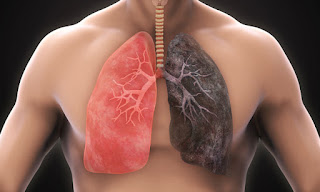Lung disease is a general term for several disorders that include airway diseases, lung tissue diseases, and lung circulation diseases, some of which may lead to respiratory failure.
The lungs are an essential part of the respiratory system. When a person breathes, the lungs take in oxygen from the air and pump it through the body’s airways and air sacs. The oxygen is then absorbed into the bloodstream and carried to the heart via the blood vessels.
Doctors use the phrase lung disease or respiratory disease to describe the many different conditions that affect the respiratory, or breathing, system.
There are three main categories of lung disease, and each affects the lungs in a different way:
- Airway diseases: These conditions make it difficult for people to breathe in regards to airflow in and out of the lungs using the airways.
- Lung tissue diseases: These conditions make it difficult for the lungs to work properly and diffuse oxygen from the airways into the bloodstream.
- Lung circulation diseases: These conditions affect the way blood flows from the heart to the rest of the body in order to deliver oxygen to the organs and tissues.
Most common lung diseases fall into one or more of these three categories. Some of the most common diseases include:
- asthma
- chronic obstructive pulmonary disease (COPD)
- bronchiectasis
- bronchitis
- pulmonary fibrosis
- sarcoidosis
- hypertension
- lung cancer
- pneumonia
- pulmonary edema
- pulmonary embolus
- influenza
Doctors tend to classify lung diseases according to the way they affect the lungs. However, the lungs are complex organs and respiratory conditions may involve more than one lung disease category.
Airway diseases
Airway diseases affect the airways that carry oxygen from the atmosphere into the body. They can make it hard for a person to breathe. They include:
Asthma
When someone has asthma, their airway can become swollen and narrow, making it hard for the person to breathe and making them feel as though they cannot get enough air. Asthma events often happen after the person has been exposed to a “trigger” such as smoke, pollution, or pet hair.
COPD
COPD thickens and damages the airways. Over time, this damage results in the lungs making more mucus than usual and clogging up the airways.
The typical symptoms of COPD are:
- coughing up lots of mucus
- wheezing
- shortness of breath
- tight chest.
Complications
People with airway diseases can have periods when their symptoms get worse, which can require hospital treatment.
Lung tissue diseases
Some lung diseases affect the lung tissue, diminishing the amount of air entering the lungs. They include:
Pulmonary fibrosis
Pulmonary fibrosis causes scarring of the lungs, which makes it difficult for the body to absorb sufficient oxygen into the bloodstream.
The most common symptoms of pulmonary fibrosis include:
- shortness of breath that gets worse during exercise
- a dry cough
- fast and shallow breathing
- tiredness
- aching joints and muscles.
Pulmonary hypertension
Pulmonary hypertension is the most common lung circulation disease. It happens when high blood pressure damages the lung’s blood vessels, which become stiff and narrow, causing the heart to pump harder. The symptoms can include:
- fatigue
- lightheadedness or fainting
- chest pain
- shortness of breath
- heart palpitations
- edema, or swelling in the feet
Complications
The possible complications of pulmonary hypertension can include:
- heart failure
- blood clots
- bleeding in the lungs
- liver damage.































0 Comments